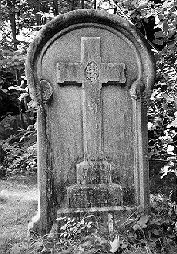Belle Elmore

The memorial to Belle Elmore
in St Pancras Cemetery
One of the many expatriates whose remains are buried in St Pancras & Islington Cemetery was born Kunigunde Mackamotzki in Brooklyn, New York, in 1873. Showing a little talent as a singer, she fancied a career in grand opera. A married stove-manufacturer set her up in a flat and paid for voice lessons. She changed her name to Cora Turner.
In 1892 she met and married a widowed doctor. She was nineteen; he was thirty. Originally from Michigan, he had first studied homeopathy then had lived in England for a time 'to pick up some medical knowledge' before qualifying as a doctor in the States. But quackery was where the money was, and in 1894 he became a patent-medicine salesman and began to prosper.
In 1897 he became manager of his firm's London office, and his wife joined him in London later that year.
She began to look for work in the music-halls. Her first engagement was under the name of Cora Motzki; unfortunately her plump figure led to her being dubbed 'the Brooklyn Matzos Ball'. Then she took the stage name 'Belle Elmore'.
She was never to get beyond the middle of the bill, mainly in suburban or provincial halls, but she was popular among fellow artistes, and became honorary treasurer of the Music Hall Ladies' Guild. She was described as being like 'a brilliant chattering bird of gorgeous plumage'.
Her marriage was not happy. Her husband was recalled to the States for a time and she began an affair with a one-man-band act. Then hubbie left his job and worked in turn for several dubious medical concerns, at one of which he became involved with a young employee whom he later took on as a typist at another firm.
Their income was erratic, but they lived quite well. She wore ermine and fox furs, and good jewellery and dresses, yet they still managed to put money away. They were said to live rather squalidly, chiefly in the kitchen, but they often entertained friends.
For a time they took in 'paying guests' – always men. She liked the company, but it was her husband who took up their breakfasts and cleaned their boots. Indeed he did much of the domestic work in the house, and let his wife look after their money and choose his suits and ties. She had excitable outbursts of temper, but he always remained pale, quiet and imperturbable. She began to drink.
In December 1909 things came to a head. His business was in trouble and needed money. She decided to leave, and gave notice to withdraw their joint savings from the bank. She started rumours that the typist had had an abortion, and that there were several candidates for who had made her pregnant.
She and her husband were, however, still together on 31 January, when they had two guests to dinner. After dinner they played whist, and it was not until 1.30 a.m. that their guests waved goodnight. 'Don't come down, Belle, you'll catch your death,' one of them called.
And that was the last time that anyone but her husband set eyes on the one-time Kunigunde Mackamotzki, a.k.a. Cora Turner, a.k.a. Cora Motzki, a.k.a. Belle Elmore, until on 13 July 1910 a Scotland Yard detective found parts of her body, containing hyoscine poison, beneath the floor of the cellar of their house at 39 Hilldrop Crescent.
Her married name had been Mrs Hawley Harvey Crippen.
Jonathan Goodman (ed.), The Crippen File (London: Allison & Busby, 1985)